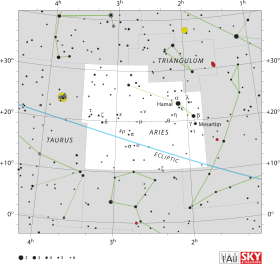33 Arietis est une étoile binaire [ 2] constellation du Bélier . 33 Arietis est sa désignation de Flamsteed . La magnitude apparente (combinée) de 5,33[ 2] œil nu . Sur la base d'un décalage annuel de la parallaxe de 14,09 mas [ 1] Terre d'environ 231 années-lumière parsecs
Le composant principal est une étoile blanche de la séquence principale , de magnitude de 5,40 et d'un type spectral A3 V. Elle possède un compagnon de magnitude 8,40 à une distance angulaire de 28,6 secondes d'arc excès d'infrarouge suggère la présence de poussière circumstellaire dans ce système. Dans la bande de 27 µm , ce disque de débris a une température moyenne de 815 K UA µm , qui a une température de 103 K [ 8]
Cette étoile était située dans la constellation obsolète de la Guêpe .
↑ a b c d e et f (en) F. van Leeuwen, « Validation of the new Hipparcos reduction Astronomy & Astrophysics vol. 474, no 2, novembre 2007 , p. 653–664 (DOI 10.1051/0004-6361:20078357 Bibcode 2007A&A...474..653V arXiv 0708.1752 S2CID 18759600 ↑ a b et c (en) P. P. Eggleton et A. A. Tokovinin, « A catalogue of multiplicity among bright stellar systems Monthly Notices of the Royal Astronomical Society vol. 389, no 2, septembre 2008 , p. 869–879 (DOI 10.1111/j.1365-2966.2008.13596.x Bibcode 2008MNRAS.389..869E arXiv 0806.2878 S2CID 14878976 ↑ (en) A. Cowley et al. A study of the bright A stars. I. A catalogue of spectral classifications The Astronomical Journal vol. 74, avril 1969 , p. 375–406 (DOI 10.1086/110819 Bibcode 1969AJ.....74..375C ↑ a et b (en) K. Osawa et S. Hata, « Three colour photometry of B8-A2 stars Annals of the Tokyo Astronomical Observatory vol. 6, 1960 , p. 148 (Bibcode 1960AnTok...6..148O ↑ (en) D. R. Palmer et al. The radial velocities spectral types and projected rotational velocities of 633 bright northern A stars Royal Observatory Bulletin vol. 135, 1968 , p. 385 (Bibcode 1968RGOB..135..385P ↑ (en) F. Royer, J. Zorec et A. E. Gómez, « Rotational velocities of A-type stars. III. Velocity distributions Astronomy & Astrophysics vol. 463, no 2, février 2007 , p. 671–682 (DOI 10.1051/0004-6361:20065224 Bibcode 2007A&A...463..671R arXiv astro-ph/0610785 S2CID 18475298 ↑ (en) 33 Ari sur la base de données Simbad Centre de données astronomiques de Strasbourg .↑ (en) D. E. Trilling et al. Debris disks in main-sequence binary systems The Astronomical Journal vol. 658, no 2, avril 2007 , p. 1264–1288 (DOI 10.1086/511668 Bibcode 2007ApJ...658.1289T arXiv astro-ph/0612029 S2CID 14867168
Liens externes
Ressource relative à l'astronomie :
